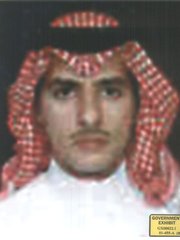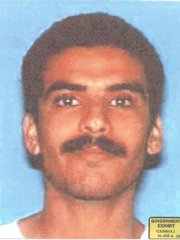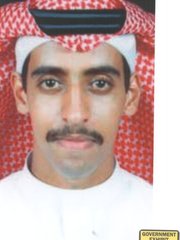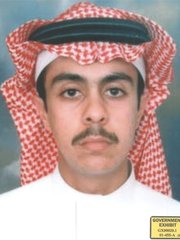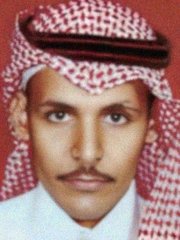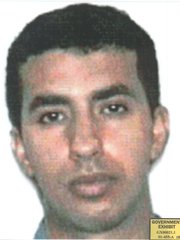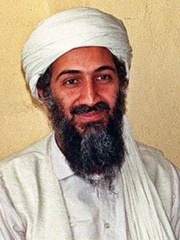
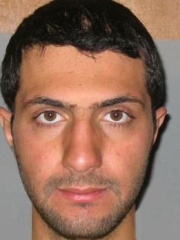
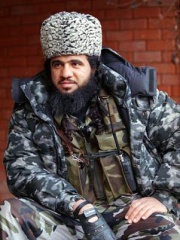
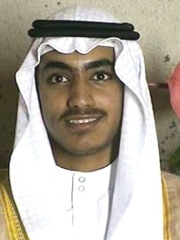
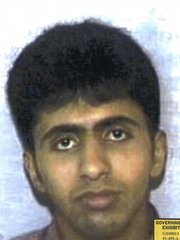
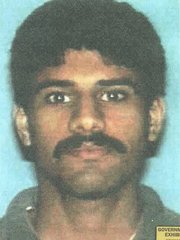
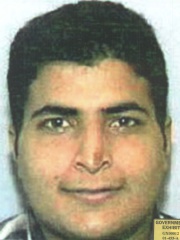
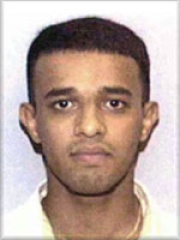
The Most Famous
EXTREMISTS from Saudi Arabia
This page contains a list of the greatest Saudi Arabian Extremists. The pantheon dataset contains 283 Extremists, 17 of which were born in Saudi Arabia. This makes Saudi Arabia the birth place of the 4th most number of Extremists behind United Kingdom, and Germany.
Top 10
The following people are considered by Pantheon to be the top 10 most legendary Saudi Arabian Extremists of all time. This list of famous Saudi Arabian Extremists is sorted by HPI (Historical Popularity Index), a metric that aggregates information on a biography's online popularity. Visit the rankings page to view the entire list of Saudi Arabian Extremists.

1. Osama bin Laden (1957 - 2011)
With an HPI of 80.32, Osama bin Laden is the most famous Saudi Arabian Extremist. His biography has been translated into 146 different languages on wikipedia.
Osama bin Mohammed bin Awad bin Laden (10 March 1957 – 2 May 2011) was the founder and first general emir of al-Qaeda. Ideologically a pan-Islamist, Bin Laden participated in the Afghan mujahideen during the Soviet–Afghan War of the 1980s, and supported the Bosnian mujahideen during the Bosnian War of the 1990s. Opposed to American foreign policy in the Middle East, Bin Laden declared war on the United States in 1996 and supervised numerous terrorist attacks in various countries, including the September 11 attacks in 2001 in the U.S. Born in Riyadh to the aristocratic bin Laden family, he studied at Saudi and foreign universities until 1979, when he joined the mujahideen fighting against the Soviet invasion of Afghanistan. In 1984, he co-founded Maktab al-Khidamat, which recruited foreign mujahideen into the war. As the Soviet war in Afghanistan came to an end, Bin Laden founded al-Qaeda in 1988 to carry out worldwide jihad. In the Gulf War, Bin Laden's offer of support to Saudi Arabia against Iraq was rejected by the Saudi royal family, which instead sought American aid. Bin Laden's views on pan-Islamism and anti-Americanism resulted in his expulsion from Saudi Arabia in 1991. He shifted his headquarters to Sudan until 1996, when he established a new base in Afghanistan, where he was supported by the Taliban. Bin Laden declared two fatāwā in August 1996 and February 1998, declaring holy war against the U.S. After al-Qaeda's bombings of U.S. embassies in East Africa in August 1998, which killed hundreds of civilians, he was indicted by a U.S. district court and listed on the FBI's Most Wanted Terrorists and Most Wanted Fugitives lists. In October 1999, the United Nations designated al-Qaeda as a terrorist organization. Bin Laden organized the September 11 attacks, which killed nearly 3,000 people. This resulted in the U.S. invading Afghanistan and launching the war on terror. Bin Laden became the subject of a nearly decade-long international manhunt led by the U.S. During this period, he hid in the mountains of Afghanistan and later escaped to neighboring Pakistan. On 2 May 2011, Bin Laden was killed by U.S. special operations forces at his compound in Abbottabad. His corpse was buried in the Arabian Sea and he was succeeded by his deputy Ayman al-Zawahiri on 16 June 2011. During his lifetime, Bin Laden was considered a war hero by many within the Islamist movement due to his role in opposing the Soviet and American interventions in Afghanistan. In the West and elsewhere, he is widely seen as a global symbol of terrorism and reviled as a mass murderer due to his orchestration of numerous terrorist attacks.

2. Abu Mohammad al-Julani (b. 1981)
With an HPI of 66.19, Abu Mohammad al-Julani is the 2nd most famous Saudi Arabian Extremist. Her biography has been translated into 63 different languages.
Ahmed Hussein al-Sharaa (born 29 October 1982), also known by his nom de guerre Abu Mohammad al-Julani, is a Syrian politician, revolutionary, and former rebel commander who has served as the president of Syria since 2025. He previously served as the emir of Hay'at Tahrir al-Sham (HTS) from 2017 to 2025 and was Syria's de facto leader from December 2024 until his appointment as president. Born in Riyadh, Saudi Arabia, to a Syrian Sunni Muslim family from Daraa and the Golan Heights, he grew up in Syria's capital, Damascus. Al-Sharaa joined al-Qaeda in Iraq shortly before the 2003 invasion of Iraq and fought for three years in the Iraqi insurgency. American forces captured and imprisoned him from 2006 to 2011. His release coincided with the Syrian revolution against the Ba'athist dictatorship of Bashar al-Assad. Al-Sharaa created the al-Nusra Front in 2012 with the support of al-Qaeda to topple the Assad regime in the Syrian civil war. As emir of the al-Nusra Front, al-Sharaa built a stronghold in the northwestern Idlib Governorate. He resisted Abu Bakr al-Baghdadi's attempts to merge al-Nusra Front with the Islamic State, leading to armed conflict between the two groups. In 2016, al-Sharaa cut al-Nusra's ties with al-Qaeda and launched a crackdown on its loyalists. Since breaking with al-Qaeda, he has sought international legitimacy by presenting a more moderate view of himself, renouncing transnational jihadism against Western nations, and focusing on governance in Syria while vowing to protect Syria's minorities. Al-Sharaa merged al-Nusra with other organizations to form HTS in 2017, and served as its emir from 2017 to 2025. HTS established a technocratic administration known as the Syrian Salvation Government (SSG) in the territory it controlled in Idlib Governorate. The SSG collected taxes, provided public services, and issued identity cards to residents, though it faced protests and criticism within Idlib for authoritarian tactics and suppressing dissent. Al-Sharaa launched an 11-day offensive against the Assad regime in November 2024 which saw swift victories in Aleppo, Hama, Homs, and Damascus; Bashar al-Assad fled to Russia as his government fell. Al-Sharaa became Syria's de facto leader, heading the post-revolutionary caretaker government from 8 December 2024 until 29 January 2025, when he was appointed president of Syria at the Syrian Revolution Victory Conference held in the People's Palace. As president, he focused on consolidating power, rebuilding state institutions, integrating military factions, and restoring Syria's international relations, including with the United States, Russia, and regional powers. Domestically, al-Sharaa pursued economic recovery, security stabilization, the return of Syrian refugees to their homes, and minority reconciliation, including signing an agreement with the Syrian Democratic Forces to integrate their military and civil institutions into the state, though negotiations on integration remained inconclusive. Al-Sharaa's first year as president saw massacres targeting Syrian Alawites and clashes in southern Syria, both involving government-affiliated troops, which led to criticism. After breaking the 1974 agreement, Israel intensified its limited invasion of southwestern Syria from the Israeli-occupied Golan Heights. Al-Sharaa reaffirmed Syria's commitment to the 1974 deal and has opposed renewed conflict with Israel. He has condemned Iranian influence. Al-Sharaa signed an interim constitution establishing a five-year transition period and announced the formation of a transitional government.

3. Ibn al-Khattab (1969 - 2002)
With an HPI of 57.84, Ibn al-Khattab is the 3rd most famous Saudi Arabian Extremist. His biography has been translated into 33 different languages.
Samir Salih Abdullah al-Suwaylim (14 April 1969 – 20 March 2002), commonly known as Ibn al-Khattab, was a Saudi-born pan-Islamist militant. He is best known for his involvement in the First and Second Chechen War, which he participated in after moving to Chechnya at the invitation of the Akhmadov brothers. The origins and real identity of Khattab remained a mystery to most until after his death, when his brother gave an interview to the press. His death in 2002 had followed his exposure to a poisoned letter, which had been delivered to him by a personal courier who was secretly recruited by the Federal Security Service (FSB) of the Russian Federation. According to American scholar Muhammad al-Ubaydi who specializes in the study of militant Islam, his continued relevance is due to the fact that he was the internationalist Salafi jihadist fighter par excellence: he was born in Saudi Arabia and had taken part in conflicts in Afghanistan, Azerbaijan, Bosnia and Herzegovina, Chechnya, Dagestan, and Tajikistan, and who in addition to his native Arabic was able to communicate in English, Kurdish, Pashto, Persian, and Russian. Compounding this was his charismatic appealing approach towards attracting non-Arab Muslims to fight for his cause and his pioneering use of modern media dissemination techniques to promote jihad, particularly by way of publishing military videos for propaganda purposes.

4. Hamza bin Laden (1989 - 2019)
With an HPI of 48.02, Hamza bin Laden is the 4th most famous Saudi Arabian Extremist. His biography has been translated into 25 different languages.
Hamza bin Laden (9 May 1989 – 2017/2019) was a Saudi-born key member of al-Qaeda. He was a son of Osama bin Laden. On 14 September 2019, U.S. president Donald Trump announced that he was killed in a U.S. counterterrorism operation on the Afghanistan–Pakistan border. In 2024, unconfirmed media reports claimed that he was still alive and a senior leader of al-Qaeda.
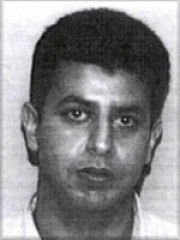
5. Wail al-Shehri (1973 - 2001)
With an HPI of 47.17, Wail al-Shehri is the 5th most famous Saudi Arabian Extremist. His biography has been translated into 19 different languages.
Wail Mohammed al-Shehri (Arabic: وائل الشهري, romanized: Wāīl ash-Shehrī; or Alshehri; July 31, 1973 – September 11, 2001) was a Saudi school teacher and terrorist hijacker. He was one of five hijackers of American Airlines Flight 11, which was flown into the North Tower of the World Trade Center as part of the September 11 attacks. Wail al-Shehri was an elementary school teacher from Khamis Mushait in the Asir region of Saudi Arabia. In early 2000, he traveled to Medina to seek treatment for mental problems. He and his younger brother Waleed traveled to Afghanistan in March 2000 and joined an Al-Qaeda training camp. The brothers were chosen, along with others from the same region of Saudi Arabia, to participate in the September 11 attacks. Once selected, al-Shehri returned to Saudi Arabia in October 2000 to obtain a clean passport, then returned to Afghanistan. In March 2001, he recorded his last will and testament on video. Al-Shehri arrived in the United States in early June 2001, staying in budget motels in the Boynton Beach area of south Florida. On September 5, 2001, al-Shehri traveled to Boston and checked into a motel with his brother. Six days later, al-Shehri arrived early in the morning at Boston's Logan International Airport and boarded American Airlines Flight 11. Fifteen minutes after takeoff, al-Shehri, along with his brother and three others, hijacked the airliner. They deliberately crashed it into the North Tower of the World Trade Center at 8:46 a.m. In the aftermath of the attacks, some news reports mistakenly reported that al-Shehri was the son of a Saudi diplomat and was still alive and well. The al-Shehri family in Khamis Mushait spoke to the media, denying those early reports, saying that the al-Shehri brothers had disappeared and have not been heard from since.

6. Mohand al-Shehri (1979 - 2001)
With an HPI of 45.63, Mohand al-Shehri is the 6th most famous Saudi Arabian Extremist. His biography has been translated into 15 different languages.
Mohand Muhammed Fayiz al-Shehri (Arabic: مهند الشهري, romanized: Muhand ash-Shehrī, or Alshehri; May 7, 1979 – September 11, 2001) was a Saudi terrorist who was a member of al-Qaeda. He was one of five al-Qaeda members who hijacked United Airlines Flight 175 and crashed it into the World Trade Center in New York City as part of the September 11 attacks (9/11). In early 2000, after dropping out of college in Saudi Arabia, al-Shehri left the country to fight in Chechnya amidst the Second Chechen War. He probably visited al-Qaeda training camps in Afghanistan. After joining al-Qaeda, he was chosen to participate in a series of coordinated terrorist attacks against the United States, which involved 19 men hijacking four American commercial flights to crash them into various targets. In October 2000, al-Shehri obtained a travel visa to be able to enter the U.S., and arrived in the country in May 2001. On September 11, 2001, al-Shehri and a team led by Marwan al-Shehhi took control of Flight 175, scheduled to fly from Boston to Los Angeles, and flew it into the South Tower of the World Trade Center complex. The impact caused the tower to collapse, killing hundreds. al-Shehri is not related to Wail al-Shehri or Waleed al-Shehri, hijackers of American Airlines Flight 11 on 9/11.

7. Nawaf al-Hazmi (1976 - 2001)
With an HPI of 45.45, Nawaf al-Hazmi is the 7th most famous Saudi Arabian Extremist. His biography has been translated into 17 different languages.
Nawaf Muhammad Salim al-Hazmi (Arabic: نواف محمد سالم الحازمي, romanized: Nawāf Muḥammad Sālim al-Ḥāzmī; 9 August 1976 – 11 September 2001) was a Saudi terrorist hijacker who was one of five hijackers of American Airlines Flight 77, which they crashed into the Pentagon as part of the September 11 attacks. Al-Hazmi and a long-time friend, Khalid al-Mihdhar, left their homes in Saudi Arabia in 1995 to fight for Muslims in the Bosnian War. Al-Hazmi later traveled to Afghanistan to fight with the Taliban against the Afghan Northern Alliance. He returned to Saudi Arabia in early 1999. Already long-time affiliates of al-Qaeda with extensive fighting experience, al-Hazmi and al-Mihdhar were chosen by Osama bin Laden for an ambitious terrorist plot to pilot commercial airliners into designated targets in the United States. Al-Hazmi arrived in Los Angeles, California, on 15 January 2000, alongside al-Mihdhar. The two settled in San Diego, staying at the Parkwood Apartments until May 2000. While in San Diego, they attended its mosque, led by Anwar al-Awlaki. The two took flying lessons in San Diego, but due to their poor English skills they did not perform well during their flight lessons and their flight instructor regarded them as suspicious. Al-Mihdhar left al-Hazmi in California for Yemen in June 2000. Al-Hazmi stayed in California until he met up with Hani Hanjour in December 2000, and they both traveled to Phoenix, Arizona. They later moved to Falls Church, Virginia, in April 2001, where the rest of the hijackers began to join them. Al-Hazmi met frequently with Mohamed Atta, the ringleader of the attacks, during the summer of 2001. The CIA reportedly received al-Hazmi's name on a list of 19 persons suspected of planning an attack in the near future. Al-Hazmi was one of the four names on the list who were known for certain. A search for al-Hazmi and other suspected terrorists commenced, but they were not located until after the attacks. The day before the 11 September attacks, al-Hazmi, al-Mihdhar, and Hanjour checked into a hotel in Herndon, Virginia. The next morning, al-Hazmi and four other terrorists, including al-Hazmi's younger brother, Salem al-Hazmi, boarded American Airlines Flight 77 at Dulles International Airport and hijacked the plane so that Hanjour could pilot and crash it into the Pentagon as part of the attacks. The crash killed all 64 passengers aboard the aircraft and 125 in the Pentagon. Following the attacks, al-Hazmi's participation was initially dismissed as that of a "muscle hijacker", but he was later revealed to have played a larger role in the operational planning than previously believed.

8. Hamza al-Ghamdi (1980 - 2001)
With an HPI of 45.31, Hamza al-Ghamdi is the 8th most famous Saudi Arabian Extremist. His biography has been translated into 16 different languages.
Hamza Salah Sa'id al-Ghamdi (Arabic: حمزة الغامدي, romanized: Ḥamza al-Ghāmdī; 18 November 1980 – 11 September 2001) was a Saudi terrorist hijacker. He was one of five hijackers of United Airlines Flight 175 as part of the 11 September attacks. Born in Saudi Arabia, Hamza al-Ghamdi left his family to fight in Chechnya and was probably sent to Al-Qaeda training camps in Afghanistan where he was chosen to participate in the 9/11 attacks. He arrived in the United States in May 2001 on a tourist visa. On 11 September 2001, al-Ghamdi boarded United Airlines Flight 175 and hijacked the plane along with his older brother Ahmed al-Ghamdi and 3 other terrorists so that lead hijacker and trained pilot Marwan al-Shehhi could crash the plane into the South Tower of the World Trade Center.

9. Satam al-Suqami (1976 - 2001)
With an HPI of 45.17, Satam al-Suqami is the 9th most famous Saudi Arabian Extremist. His biography has been translated into 20 different languages.
Satam Muhammad Abd al-Rahman al-Suqami (Arabic: سطَّام مُحَمَّدُ عَبْدِ اَلرَّحْمَـٰن السُّقامي, romanized: Saṭām Muḥammad ʿAbd ar-Raḥmān as-Suqāmī; June 28, 1976 – September 11, 2001) was a Saudi terrorist hijacker. He was one of five hijackers of American Airlines Flight 11 as part of the September 11 attacks in 2001. Al-Suqami was recruited into al-Qaeda around 1999, along with his friend Majed Moqed, who was one of the hijackers of American Airlines Flight 77. He traveled to Taliban-controlled Afghanistan where he would be chosen to participate in the 9/11 attacks. He arrived in the United States in April 2001. On September 11, 2001, al-Suqami boarded American Airlines Flight 11 and participated in the hijacking of the plane so that it could be crashed into the North Tower of the World Trade Center as part of the coordinated attacks. He is believed to have perpetrated the first fatality of the attacks in killing passenger Daniel Lewin in the process of hijacking the plane. Al-Suqami died along with everyone else on the plane on impact with the North Tower.

10. Waleed al-Shehri (1978 - 2001)
With an HPI of 43.34, Waleed al-Shehri is the 10th most famous Saudi Arabian Extremist. His biography has been translated into 19 different languages.
Waleed Mohammed al-Shehri (Arabic: وليد الشهري, romanized: Walīd ash-Shehrī'; 20 December 1978 – 11 September 2001) was a Saudi terrorist hijacker. He was involved in the September 11 attacks against the United States in 2001. He was one of the five hijackers who took control of American Airlines Flight 11, which was then flown into the North Tower of the World Trade Center. Born in Saudi Arabia, al-Shehri had been a student until he accompanied his mentally ill brother to Medina. Later, he and his brother Wail went to Chechnya, where they fought in support of a jihadist insurgency against Russia. However, they were soon redirected to Taliban-controlled Afghanistan, where they were recruited to carry out the 11 September attacks. After their selection, the brothers were moved to a safehouse in Pakistan before flying out to the United Arab Emirates and starting the process to enter the United States. In April 2001, al-Shehri arrived in the United States on a tourist visa. On the day of the attacks, al-Shehri, his brother, and the other hijackers took control of American Airlines Flight 11, following which Mohamed Atta flew the plane into the North Tower in a suicidal attack.
People
Pantheon has 17 people classified as Saudi Arabian extremists born between 1957 and 1989. Of these 17, 1 (5.88%) of them are still alive today. The most famous living Saudi Arabian extremists include Abu Mohammad al-Julani. The most famous deceased Saudi Arabian extremists include Osama bin Laden, Ibn al-Khattab, and Hamza bin Laden. As of April 2024, 9 new Saudi Arabian extremists have been added to Pantheon including Mohand al-Shehri, Nawaf al-Hazmi, and Ahmed al-Nami.
Living Saudi Arabian Extremists
Go to all RankingsDeceased Saudi Arabian Extremists
Go to all RankingsOsama bin Laden
1957 - 2011
HPI: 80.32
Ibn al-Khattab
1969 - 2002
HPI: 57.84
Hamza bin Laden
1989 - 2019
HPI: 48.02
Wail al-Shehri
1973 - 2001
HPI: 47.17
Mohand al-Shehri
1979 - 2001
HPI: 45.63
Nawaf al-Hazmi
1976 - 2001
HPI: 45.45
Hamza al-Ghamdi
1980 - 2001
HPI: 45.31
Satam al-Suqami
1976 - 2001
HPI: 45.17
Waleed al-Shehri
1978 - 2001
HPI: 43.34
Ahmed al-Nami
1977 - 2001
HPI: 43.03
Khalid al-Mihdhar
1975 - 2001
HPI: 42.64
Ahmed al-Ghamdi
1979 - 2001
HPI: 42.64
Newly Added Saudi Arabian Extremists (2025)
Go to all RankingsMohand al-Shehri
1979 - 2001
HPI: 45.63
Nawaf al-Hazmi
1976 - 2001
HPI: 45.45
Ahmed al-Nami
1977 - 2001
HPI: 43.03
Khalid al-Mihdhar
1975 - 2001
HPI: 42.64
Ahmed al-Ghamdi
1979 - 2001
HPI: 42.64
Saeed al-Ghamdi
1979 - 2001
HPI: 41.62
Majed Moqed
1977 - 2001
HPI: 41.25
Ahmed al-Haznawi
1980 - 2001
HPI: 41.13
Salem al-Hazmi
1981 - 2001
HPI: 40.71
Overlapping Lives
Which Extremists were alive at the same time? This visualization shows the lifespans of the 16 most globally memorable Extremists since 1700.

